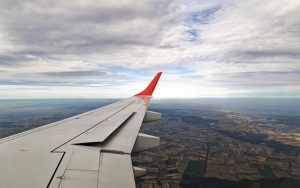
Flaps are a common feature of airplane wings. Located on the trailing edge, they are used to increase drag and lift. Flaps are hinged surfaces that pilots can control from the cockpit. By default, they are typically retracted so that the flaps remain flush with the rest of the wing. During takeoffs and landings, though, pilots may extend the flaps partially or completely. Here are five fun facts about wing flaps.
#1) Not the Same as Slats
Flaps aren’t the same as slats. While they both consist of controllable, hinge-like devices on an airplane’s wings, they are located in different areas and used for different purposes. As previously mentioned, flaps are located on the trailing edge and used to increase drag and lift. Slats, on the other hand, are located on the leading edge and used to assist with lift at low flight speeds.
#2) Extended to 5 to 15 Degrees
Pilots can adjust the degree to which the airplane’s flaps are extended. A typical extension consists of a 5- to 15-degree angle. The angle of extension affects how much lift and drag the flaps produce. When fully retracted — meaning the angle of extension is 0 degrees — the flaps won’t contribute to any lift or drag. Rather, pilots must extend them partially to take advantage of their benefits.
#3) Used for Lift During Takeoffs and Drag During Landings
Flaps are used to generate additional lift during takeoffs and additional drag during landings. When extended during takeoffs, flaps allow airplanes to generate more lift while simultaneously reducing climb rate. Without flaps, airplanes would need more runway space to take off. When extended during landings, they allow airplanes to generate more drag while simultaneously reducing stall speed.
#4) Different Types
Not all flaps are the same. There are many different types of flaps, each of which features a unique design that distinguishes it from the rest. Common flap types include plain, split, slotted, krueger, fowler and junkers.
#5) Slotted Are the Most Common
Of all the different types of flaps, slotted is the most common. You can find them on small airplanes as well as large commercial airliners. Slotted flaps are characterized by the presence of a narrow opening or “slot” that opens between the flap itself and the rest of the wing when the flap is extended. This opening allows highly pressurized air to sweep over the flap, thereby boosting lift.



